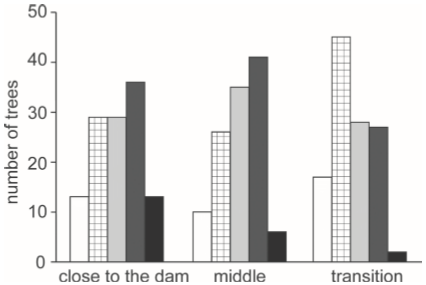Introduction
Anthropogenic impacts can lead to a structural evolution from open to closed vegetation, with increased biomass reported in various areas of the Cerrado (Moreira, 2000). Variations in water availability due to the presence of dams (Nilsson and Bergreen, 2000, Vale et al., 2013a) and fires constitute examples of anthropic disturbances that affect plant communities (Hoffman and Solbrig, 2003). In seasonal environments, such as the Cerrado, these impacts can determine the predominant physiog- nomy and the proportion that exists between open (savannahs) and closed (forests) areas (Marimon Júnior and Haridasan, 2005; Pinheiro and Durigan, 2009; Lopes, Vale and Schiavini, 2009); open areas have less water and experience more fires while closed areas have more water and a lower incidence of fires. In Brazil, such open savannahs are called “South American Savannahs” or “Cerrado” and are very similar structurally to the African savannahs (Dexter, 2015), with twisted trees with thick bark and a grass stratum that occupies an important por- tion of the vegetation, although there is variation in the floristic patterns. Here, we focus on the impact of a dam on an open cerrado plant community that became a closed forest after 35 years in proximity to the artificially water created by the reservoir.
Changes from open to closed areas are particularly important because it is not only structural aspects (such as number of trees, basal area and individual height) that are modified, but also ecological functions, such as the provision of resources for fauna and carbon assimilation (Vale, Schiavini, Oliveira and Gusson, 2010). In protected areas, such changes can alter the primary protective purpose related to the local diversity of fauna and flora, as well as influence the various biological roles played by animal and plant species.
These biological roles are related to the occurrence of species and their attributes (Walker, Kingzig and Langridge, 1999). Many species can thus play similar roles within the community and the ecosystem (Hooper and Dukes, 2004; Walker et al., 1999). These species that share the same attributes may belong to “functional groups”. A functional group is a set of species with similar characteristics or that present a similar use of resources (Lyon and Sagers, 2003; Médail, Roche and Tatoni, 1998). The species within a functional group play a similar role within the community or the ecosystem (Blondel, 2003; Vale et al., 2013 b). Classification into functional groups allows the gathering of a large number of species into a small group of functional types that present the same responses to disturbances or similarities in terms of processes of dispersion, competition and survival (Hubbel, 2005; Skov, 2000).
To achieve a good representation of ecological roles, we must choose traits that represent important functions relating to the ecosystems (Vale et al., 2011). However, plants have many attributes that may be used for identi- fying functional groups (Pendry et al., 2007) and the choice of such attributes must be clearly related to the role played by the species within the ecosystem. In this study, we focus on attributes that may represent the impacts caused by the presence of a dam. We therefore consider attributes related to local animal-plant interactions, such as pollination and dispersion, since these vary according to the availability of water and the presence of fauna and flora within an ecosystem (Nilsson, 1996).
Various animal groups can occupy different positions in the vertical space formed by vegetation. Birds, mammals (Clark, Poulsen and Parker, 2001) and invertebrates (Gossner and Muller, 2011) may prefer to occupy different vertical layers in a forest, for instance. This preference may be connected to the direct attributes of the tree com- munity, such as the abundance of resources, temperature, leaf density, and luminosity (Campbell and Donato, 2014; O’Hanlon and Holwell, 2011; Walther, Clayton and Gregory, 1999).
Growth responses under high luminosity and mortality under shade are particularly important in forests (Pearson, Burslem, Goeriz and Dalling, 2003), but light is not restricted in open areas. Furthermore, deciduousness can interfere with luminosity at ground level, which can become more marked in soils that present a significant hydric deficit during dry periods. Furthermore, species from deciduous forests currently present rapid growth due to high carbon assimilation (Cornelissen, Diez and Hunt, 1996). On the other hand, evergreen species tend to produce and keep their leaves throughout the year in milder or moist environments, thus hindering the establishment of species that demand direct light below the canopy of the trees. Another important feature is tree-bark thickness; this property provides savannah species with an increased resistance to fire compared to forest species (Hoffman and Solbrig, 2003). We cannot disregard this trait, because forest areas often border the savannahs and fire events can thereby favor the savannah species (Hoffman and Solbrig, 2003).
Finally, in environments with low water availability, seed desiccation tolerance can play a key role for species survival over time. Seeds that are more tolerant to desiccation are able to survive under conditions of lower humidity without losing their viability when hydrated. Thus, the species that present this feature can constitute a persistent seed bank. In contrast, seeds that are sensitive to desiccation quickly lose their viability, although they can constitute a saplings bank in environments with high soil moisture (Tweddle, Dickie, Baskin and Baskin, 2003).
It is difficult to understand the consequences of proximity to the water line on savannah drought-adapted species, and it also remains unknown whether ecosystem functions will be lost or change after many years of dams impacts. Furthermore, dams constructions are increasing all around the world, and we must understand the changes in vegetation after damming in order to apply more appropriate conservation and management actions in the future. We assumed three hypotheses: 1) the sector close to the dam will have more forest species, with higher basal area and individual tree heights; 2) due to the presence of more closed vegetation, the sector close to the dam will have less small plants; 3) the influence of the dam will change the ecological roles within this community, with more marked effects on sectors in more close proximity to the water.
Objectives
Considering the structural and functional importance of open (in this case, cerrado stricto sensu) and closed (in this case, forest) areas, we aim to evaluate changes in acerrado area after 35 years under the influence of a hydroelectric dam. The main objective was to understand the impacts of the dam on the savannah communities. This area was previously far from any water source, but currently lies close to a large body of water. Thus, in 2009, the entire open cerrado border became forest; however, it still preserves some cerrado characteristics, mainly at a distance from the lakeshore.
Study area and sampling methods
This study was carried out in a forest fragment in the state of Minas Gerais, southeastern Brazil. The climate of the zone is characterized by warm temperatures throughout the year with a rainy summer and dry winter, i.e. Aw, according to Köppen (1948). The forest is located at the “Pirapitinga Ecological Station” (ESEC - Fig. 1), close to the Três Marias Dam, in Minas Gerais, Brazil. Damming took place in 1962 and ESEC became an island (Gonçalves-Alvim and Fernandes, 2001). Flood elevation varies from 559 m to 568 m and the area is around 1090 ha (Azevedo, 1987). At present, the forest canopy is rarely >10 m height and there are many Bromeliaceae on the ground. Species of Bromeliaceae are usually high light-demanding species that cover large areas on the ground, and clearly affect the establishment of other plant species. Far from the water, there is a transition between the forest and a cerrado vegetation. Thus we divided the forest in three sectors: 1) “close”, i.e. 0 m - 20 m from the dam; 2) “middle”, i.e. 40 m - 60 m from the dam, but still about 50 m away from the cerrado stricto sensu area; and 3) “transition”, 80 m - 100 m from the dam and closer to the typical cerrado vegetation.
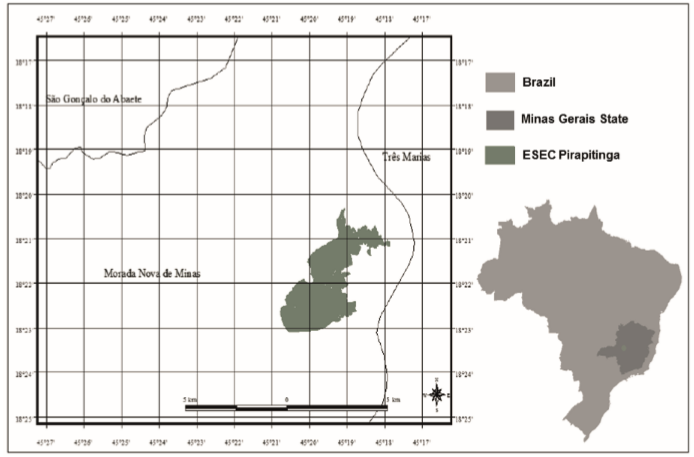
Figure 1 Location of the Pirapitinga Ecological Station (ESEC), which became an island with damming of the area 35 years ago, State of Minas Gerais, Brazil. Source: Giácomo, 2009.
We used the square-point method (Cottam and Curtis, 1956) for sampling trees. This method consists of sampling the four first trees close to the square point. Only trees with circumference at breast height (CBH) >15 cm were included. We sampled 90 points arranged into 6 parallel transects located 100 m apart, for a total of 360 sampled trees. In each transect, we allocated 15 square points, 5 close to the forest border (“close”), 5 in the middle forest (“middle”), and 5 in a transition site with cerrado stricto sensu (“transition”). Each set of 5 points in the same sector was regarded as 1 sample.
We measured all of the young trees (CBH <15 cm), seedlings and saplings in 75 plots (2 m x 2 m); these individuals were regarded as a regeneration layer. Regenera- ting individuals were classified into 2 categories: 1) seedlings, saplings, and young trees <1 m height; and 2) young trees >1 m height. The number of species of Bromeliaceae was determined in these plots. To compare these structural parameters, we used Kruskall-Wallis and post hoc Median tests, both non-parametric tests, since the data did not comply with the assumptions of normality.
We calculated the richness and density of the arboreal and regenerating strata within the “close”, “middle”, and “transition” sectors. We compared the basal area and individual tree heights between these sectors using analysis of variance (ANOVA), followed by an a posteriori Tukey test with a 5% significance level (Wilkinson, 2002).
Tree community functional analysis
This analysis was performed for all tree species found within the three sectors. For each species, three physiological traits were evaluated: 1) shade tolerance, 2) deciduousness and 3) seed desiccation tolerance. In addition, two structural traits were considered: 4) vertical strata; and 5) bark thickness. Finally, there were 2 animal-plant interaction types: 6) dispersal syndrome; and 7) pollination syndrome (Table 1). We obtained information relating to the ecological attributes from scientific papers and specialized books, as well as through field observation and consulting specialists.
Table 1 Traits and their respective ecological functions used for obtaining the distance matrix.
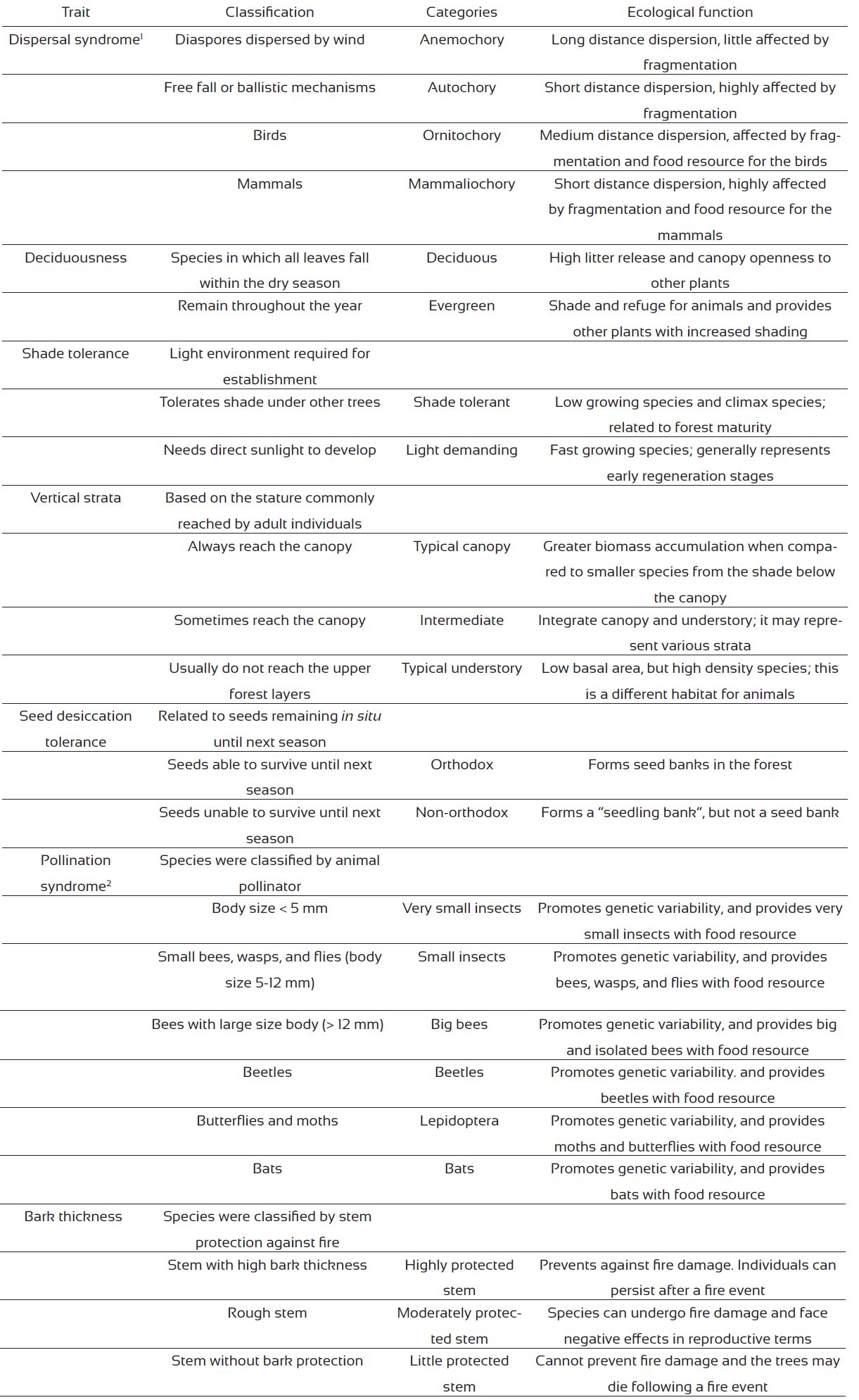
1 = Pijl (1982); 2 = Faegri and Pijl (1979)
A matrix with the tree species and 25 traits was thus adopted for analysis. We converted data to a presence/absence matrix with species and their ecological attributes. An ecological distance matrix was then determined (Petchey and Gaston, 2002). The functional groups were revealed by two analysis types, using the distance matrix and a “cluster analysis”, as explained below.
Cluster analysis
The groups were defined by Euclidian distance and a dendrogram generated using the group average. Multivariate clustering methods were used to determine which plant species groups could emerge. These methods calculate similarity or measurements of association, based on the extent to which species share attributes (Leishman and Westoby, calculated for the generated dendrogram; since this is equivalent to Pearson’s coefficient, we proposed it as a concordance measure between the obtained group and the original distance matrix (Bussab and Morettin, 1990). All these analyses were performed using the software Fitopac-Shell, version 1.6.4 (Shepherd, 2004)
Once the functional groups were found, we performed analysis of variance to test differences with regard to the abundance of functional groups within the three sectors (close, middle and transition), followed by a Tukey test. The same procedure was adopted to address the abundance of species traits at all three sectors.
Results
We found 57 species, 39 close to the dam, 38 in the middle sector and 29 in the transition site in the cerrado area (Table 2); however, only 18 species occurred in all three sectors. We observed 10 exclusive species in the sector close to the dam, in the middle sector there were 9 exclusive species but only 2 species were exclusive to the transition sector. Species abundance also varied between the sectors. Many species were more abundant in one sector. Alibertia edulis and Qualea parvifolia were much more abundant close to the dam. Siparuna guianensis, a typical forest understory species, was the most abundant species in the middle sector, presenting few individuals in other sectors. Vatairea macrocarpa and Qualea grandiflora, two typical cerrado species, had more individuals in the transition site in the cerrado (Table 2).
Table 2 Species list and their abundance in a cerrado physiognomy at the “Pirapitinga Ecological Station”, Minas Gerais, Brazil.
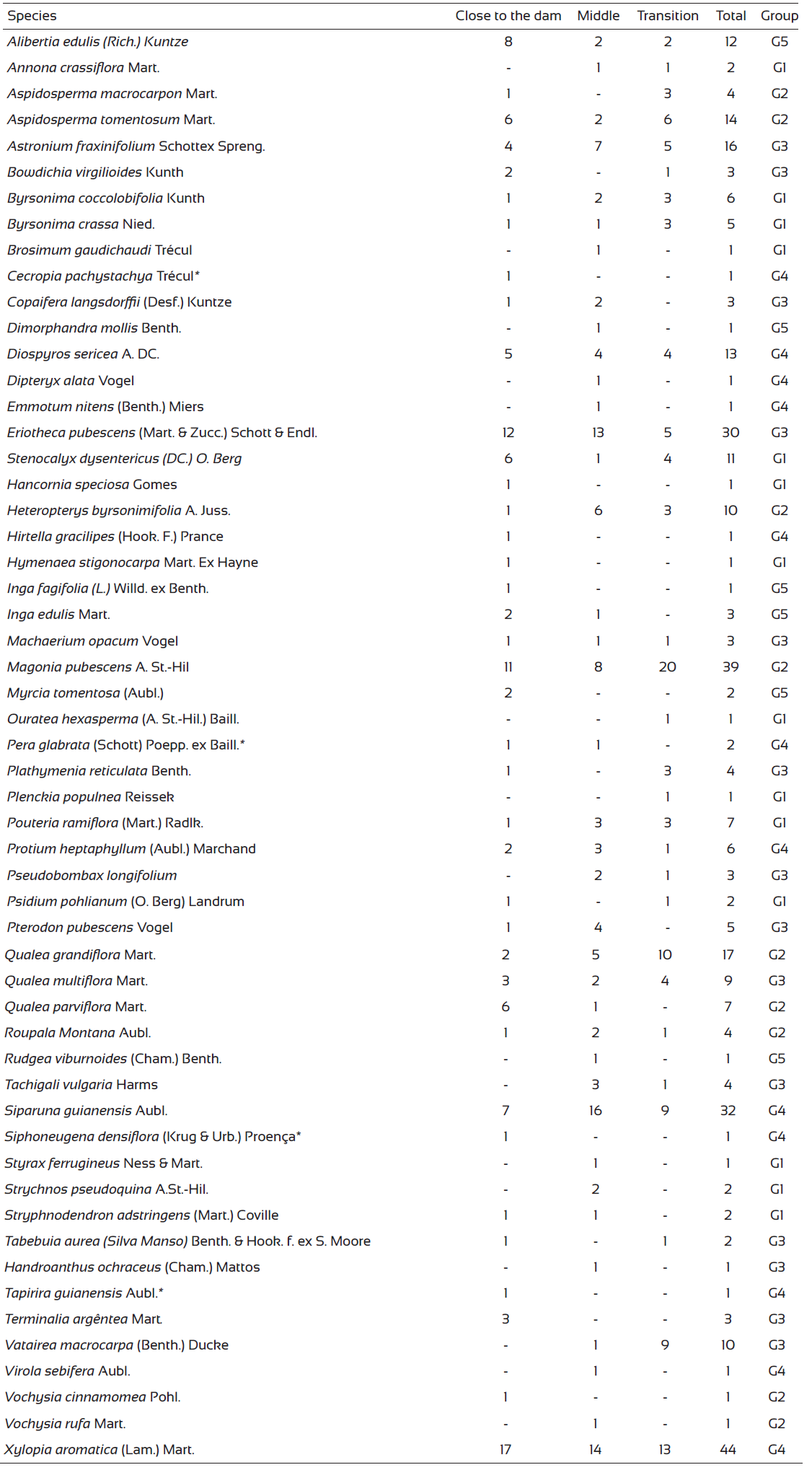
*Species usually found in forest with abundant water resources.
A pattern was found in terms of basal area (F = 4.32, p = 0.015) and individual heights (F = 9.82, p < 0.001): these structural parameters were higher in the middle sector (Fig. 2A and 2B). In the regeneration layer, the density of plants >1 m height did not show a difference (Fig. 3B; H = 7.02, p = 0.30), however, for individuals <1 m height (H = 26.96, p = 0.002) and bromeliad species (H = 14.37, p = 0.008) the lowest values occurred in the sector close to the dam (Fig. 3A and 3C).
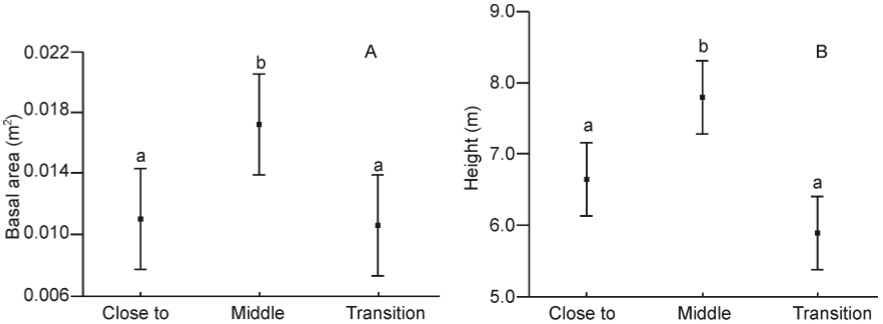
Figure 2 Analysis of variance of basal area (A) and height (B) in three sectors of a cerrado area at the “Pirapitinga Ecological Station”, Minas Gerais, Brazil. Lower case letters denote the results of a post hoc Tukey test; different letters (a and b) represent significant differences (p <0,05).
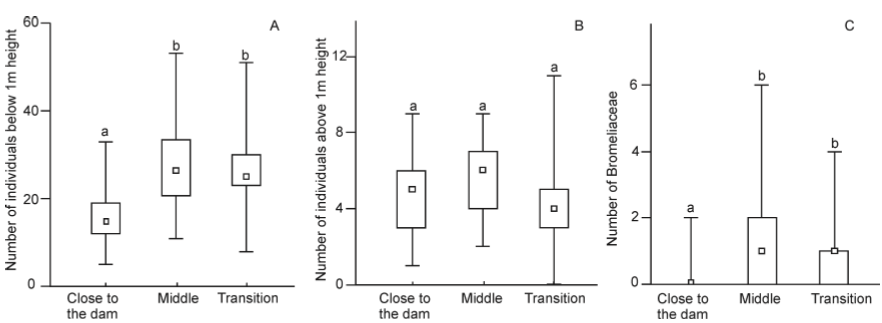
Figure 3 Kruskall-Wallis test to determine the number of individuals above and below 1 m in height (A and B, respectively), as well as the number of Bromeliaceae (C) in the three sectors of a cerrado area at the “Pirapitinga Ecological Station”, Minas Gerais, Brazil. Lower case letters (a, b and c) represent the results of median test. Different letters represent significant differences (p < 0,01).
Tree functional groups
The cluster forms 5 groups (Figure 4) and the pollination syndrome was the only species trait not useful for group formation. The 5 groups clearly have distinct functions (Table 2). Two groups present typical savannah species traits (G1 and G2): they are short (up to 6 m in height), deciduous species (a feature typical of seasonal environments), present prior pollination by small insects, moths and large bees (well-known pollinators in cerrado areas). Most species from both groups also have stems that are protected against fire. These groups basically differ in terms of dispersion: Group G1 provides mammals and birds with food resources while G2 is dispersed by wind. Few species from G1 are non-orthodox, meaning that this group can form both seed and seedling banks within the rainy season.
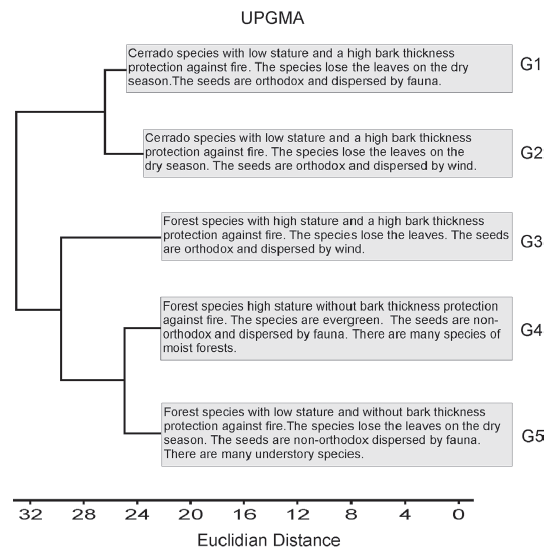
Figure 4 Functional groups based on ecological distance formed by clustering in a cerrado forest in southeastern Brazil. The cluster was defined by Euclidian distance and group average. Groups characteristics are shown in Table 2.
The other three groups are formed by traits more typical of forest species; however, they are clearly distinct. G3 and G4 are formed by taller species (usually > 10 m), but G5 has strictly small trees. G3 is the only forest spebarks. This group may be regarded as the most protected in case of a fire event, since, in addition to the thickness of the trunks and bark, its individuals are tall.
G4 is also a tall group; however, its individuals do not have a marked protection against fire. This may be regarded as the group most different from savannah in the forest, since it consists of many shade-tolerant species. Some species from this group, such as Protium heptaphyllum, Siparuna guianensis, Ocotea corymbosa, Pera grablata, and Tapirira guiannesis, are also observed in moist forest physiognomies. In this way, the group clearly represents the influence of the dam by considering the former cerrado vegetation. This group consists of evergreen species and provides food resources to the fauna, especially to bird species. This is the only group that presents pollination by very small insects; however, most pollination is provided by small insects, just like the other groups. This group is also non-orthodox and can form a seedling bank within the rainy season.
G5 also has non-orthodox species; however, these differ from those of G4, since they provide mammals and birds with food resources. This group may be highly affected by fire, because it consists of small species with no significant protection against fire. It is also the smallest group, with only 7 species - most of which are shade-tolerant species from the moist forest understory.
Comparing the groups formed close to the dam and in the middle sector, there is a lower number of short trees (G1 and G2 - groups of savannah species), a high number of tall forest trees (G3 and G4) and the highest number of short forest trees from the forest understory (G5) close to the dam (Fig. 5). The opposite occurs in the transition sector, which has a higher number of cerrado species, and the lower number of forest species, from groups 3 and 4. In the middle sector, the predominant groups were G4 and G3 (tall forest species) with few G1 and G2 trees (savannah species).
Discussion
The influence of the dam on the cerrado vegetation after 35 years is clear; the tree community, previously regarded as cerrado stricto sensu (Giácomo, 2009), presented forest characteristics due to the establishment of the many forest species that currently share the space with the cerrado species. Floristic composition is still quite similar to that of cerrado vegetation, and includes species from cerrado stricto sensu, such as Qualea parviflora, Eriotheca pubescens, Magonia pubescens, and Xylopia aromatica (Ratter, Bridgewater and Ribeiro, 2003; Lopes, Vale, Oliveira and Schiavini, 2011). However, species from moist soils were also observed, such as Alibertia edulis and Protium heptaphyllum. Even small changes in the water regime can induce changes in vegetation structure (Gusson, Vale, Araújo and Schiavini, 2012; Vale et al., 2013a) and the dam clearly favors water-associated species, such as those observed in other dams (Vale et al., 2013a). Some recent studies have shown that richness can increase over time, due to the establishment of moisture-associated associated species in sectors near the lakeshore created by the dam (Vale et. al., 2015). However, for the following three reasons, this increase in species does not compensate for those lost due to the dam construction: 1) species richness in dammed riparian forests is lower than that of non dammed riparian forest (Liu, Liu, Liu, Song and Zhang, 2013;2) the new species are different to those that existed in the area prior to construction of the dam (here the cerrado species are clearly fewer in sectors near the water and 3) the flooded area destroys the past systems, and this loss is difficult to replace.
Many of these species have thin trunks, are shade- tolerant and from the forest understory. They are there- fore usually short trees, such as A. edulis. Other studies show that the bark thickness of cerrado species is three times greater than that of forest species (Hoffman and Solbrig, 2003), and the basal area is even lower.
The sector close to the dam may be regarded as an edge where the wind can topple big trees, decreasing the total basal area (Laurance et al., 2006). The middle sector contained more typical canopy species, such as Astronium fraxinifolium, Pterodon pubescens, and Copaifera lansdorffii, compared to the other sectors. This sector there fore presented the highest basal area and height of trees. These canopy tree species in the middle sector are commonly found in seasonal semideciduous forest (Lopes, Schiavini, Oliveira and Vale, 2012), which is often associated with streams, confirming that the influence of the dam can reach a distance of 40-60 m from the water's edge.
Despite the high basal area, many small trees colonize the middle sector and the large trees are distant from each other, creating open spaces. The same occurs in the transition sector, but the trees are smaller. These open patches provide sunlight conditions and facilitate the establishment of small light-demanding plants (many <1 m height). The occurrence of many Bromeliaceae on the ground in the middle and transition sectors confirms the high light incidence. Savannahs are considered open areas and this feature means that these areas are still influenced by their savannah history prior to construction of the dam. Changes after damming are therefore focused on the sector close to the dam, 0 to 20 m far from the river, at least for some vegetation structures.
In the transition sector, the predominance of savannah species is clear; there are many individuals of species such as Qualea grandiflora and Magonia pubescens, and many other small trees, as well as large trees such as Vatairea macrocarpa. Small trees are related to forest edges (Lima-Ribeiro, 2008; Laurance et al., 2006) and both the sector close to the dam and the transition sector constitute forest edges. However, one is influenced by the dam and the other by the savannah vegetation. The middle sector is thus protected to a greater extent from border effects and consequently presents the biggest trees.
The larger number of small trees (< 1 m height) and Bromeliaceae (light-demanding species on the ground) in the transition sector implies an environment with more sunlight, in contrast to the sector close to the dam, which is a shaded environment. Savannah plant communities are open areas without light limitation unlike the forest, where a large amount of light is intercepted by the species that form the canopy (Poorter, Bongers and Bongers, 2006). Moreover, high soil moisture can kill seedlings and young trees due to hypoxia or anoxia (Nilsson and Bergreen, 2000), hindering plant establishment.
Perhaps the change from a cerrado physiognomy to a forest physiognomy is not only the result of the dam. The ESEC is currently a protected area and fire, normally a common disturbance in cerrado areas, is infrequent. When protected from fire events, some cerrado communities can turn into more closed environments and, over time, can become forests (Durigan and Ratter, 2006). These areas, for instance, had not undergone a fire event for 38 years (Durigan and Ratter, 2006), facilitating the establishment of forest species, which would normally have been destroyed by fire events in the absence of any form of timber protection.
This change in functional group species (based on traits) not only suggests structural changes, but also changes in ecological roles. Forests contain a large amount of animals that forage throughout the year for fruits and pollen (Oliveira and Paula, 2001; Pinheiro and Ribeiro, 2001; Vale et al., 2013b), whereas the production of fruits and flowers in savannahs is concentrated in the late dry period (Oliveira and Paula, 2001) and resources for fauna may be insufficient during other periods.
Due to the absence of fire and/or the presence of the dam, this community clearly assumes the characteristics of a seasonal forest, since many seeds do not have desiccation tolerance, there are evergreen plants, those without bark protection and those dispersed by animals, as well as shade-tolerant trees (groups 4 and 5 are the most representative of these traits). However, some cerrado characteristics still remain, such as deciduous small trees with large bark thickness, and this may be due to their savannah history. With no fire events in the area, more forest species can establish (especially species from groups 4 and 5), assisting the conversion into forest; however, a monitoring survey would be required in order to provide further data pertaining to this issue.
Conclusion
After 35 years of influence of water from the dam, the cerrado stricto sensu has altered its structure, floral composition and functional traits. Patches close to the dam water now act as a forest edge and contain many water-associated species, differing strongly in this respect from a savannah. The damming influence was found at a distance of at least 40-60 m from the artificial lakeshore and this was evidenced by the establishment of big trees and a well developed understory, in contrast to the savannah which does not present such a structure. Functionally, the tree species that colonized these sectors (up to 60 m in distance from the water) had thinner bark and thus less protection against fire, were taller and did not lose their leaves in the dry season, all of which are common traits for moist forest. Clearly, many years of the dams influence has changed the community and converted an open cerrado phytophysiognomy into a closed forest community, at least within a distance of 60 m from the watere's edge and management of these areas must take this fact into full account.











 nueva página del texto (beta)
nueva página del texto (beta)

